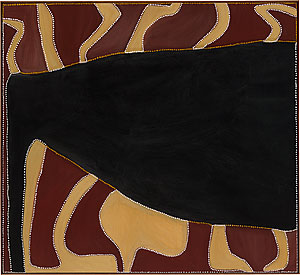
Rover Thomas – Cyclone Tracy, 1991
Warmun (Turkey Creek), Kimberley, Western Australia, Australia
Painting, natural earth pigments and binder on canvas
© the Artist, Courtesy Warmun Art Centre
CONTEXT
As Aboriginal Art appeals to audiences that grow wider and wider every year throughout the world, Europe commits to supporting and promoting Australian Indigenous Art by consistently incorporating it on its cultural agenda. Summer in France saw the unveiling of Lena Nyadbi’s stunning work Dayiwul Lirlmim on the rooftop of the musée du quai Branly (Paris), while an exceptional show is about to open this fall in Bordeaux, at the Musée d’Aquitaine: entitled “Vivid Memories: An Aboriginal Art History,” the exhibition explores the History of Australian Indigenous Art in its relationship to the ancient and the modern, the old and the new.
In this context of renewed and growing interest in Australian Indigenous Art in Europe, the Royal Academy of Arts in London presents, from September 21 to December 8, 2013 the first survey of Australian art in the UK in over 50 years. The exhibition, which features 146 artists, reveals the development of Australian Art through over 200 works, including paintings, prints and drawings, watercolours, photographs and multimedia works, incorporating settlers’ images of the land from the beginning of the nineteenth century to today, together with Art by Aboriginal Australians.
For this first exhibition exclusively devoted to Australian Art in the UK, the British curator, Kathleen Soriano, Director of Exhibitions at the Royal Academy, chose the landscape as a point of entry for the show, so as to explore the influence of the landscape on Australian art, as well as the country’s growing sense of national identity, away from European tradition.
The exhibition includes works by Aboriginal artists such as Albert Namatjira, Rover Thomas, Emily Kame Kngwarreye, Fiona Foley and Gordon Bennett. The talented artist Judy Watson was also commissioned to create a new permanent sculpture to be displayed in the academy’s courtyard. Based on a bowerbird’s mating structure, it is a larger, six-metre-tall version of her artwork Fire and Water in Canberra.
Nineteenth-century European immigrants such as John Glover and Eugene von Guerard will also feature, as well as the Australian Impressionists whose paintings relied heavily on the mythology of the Australian bush: Arthur Streeton, Tom Roberts (a student of the Royal Academy Schools), Charles Conder and Frederick McCubbin. Early Modernists such as Margaret Preston, Grace Cossington Smith and Roy de Maistre will hang alongside the leading twentieth century painters: Arthur Boyd, Rosalie Gascoigne, Fred Williams, Brett Whiteley and Sidney Nolan, with the exhibition ending in the twenty-first century with internationally recognised artists such as Shaun Gladwell, Bill Henson and Tracey Moffatt.
By Bénédicte Vachon
‘AUSTRALIA’
Australia is the most significant survey of Australian art ever mounted in the UK. Focusing on the influence of the landscape, this ambitious exhibition brings together works from the most important public collections in Australia, the majority of which have never been seen in the UK before.
HRH The Prince of Wales, who is the Patron of the exhibition, said: “I can hardly believe that it is now almost fifty years since I first visited Australia. It was during that first stay that, like many before me, I was deeply struck by the distinctive colours and light of Mackellar’s ‘sunburnt country’… It is an extraordinary achievement that the Royal Academy of Arts and the National Gallery of Australia have been able to bring together so many important works for the first time outside Australia.”
Australian museums have to manage with the fact that some of the most famous Australian paintings are absent of their collection for almost five months. The National Gallery of Australia, which has helped curate the exhibition, is contributing around 100 works (they are anticipating complaints as a part of their collection will be absent). It is also providing money from its major donors to fund the survey in the hope it will increase international awareness of the strength and scope of our indigenous, contemporary and historical talent. The Australian government has put $200,000 into the exhibition, and another $50,000 towards satellite events featuring Australian film, literature and theatre.
The story of Australian Art is inextricably linked to its landscape: an ancient land of dramatic beauty, a source of production, enjoyment, relaxation and inspiration, yet seemingly loaded with mystery and danger. For Australian artists, this deep connection with the landscape has provided a rich seam of inspiration for centuries. In 1948, the Australian artist, and Royal Academician, Sidney Nolan said of his iconic Ned Kelly series that it was ‘a story arising out of the bush and ending in the bush’. He believed strongly that an understanding of landscape was central to his work, giving meaning to place, and commented that he found ‘the desire to paint the landscape involves a wish to hear more of the stories that take place in the landscape’.
The exhibition maps the period of rapid and intense change; from the impact of the first settlers and colonisation on the indigenous people to the pioneering nation-building of the nineteenth century, through to the enterprising urbanisation of the last century. Reflecting the vastness of the land and the diversity of its people, early, as well as contemporary Aboriginal art sits alongside the work of the first colonial settlers, immigrant artists of the twentieth century and the work of some of today’s most established Australian artists.
Dr Ron Radford AM, Director of the National Gallery of Australia said: “This partnership between the Royal Academy of Arts and the National Gallery of Australia is a great opportunity to present Australia’s strong visual arts tradition, particularly that of land and landscape, both indigenous and non-indigenous, to audiences in Europe.”
SOURCE: The Royal Academy of Arts, London, United Kingdom